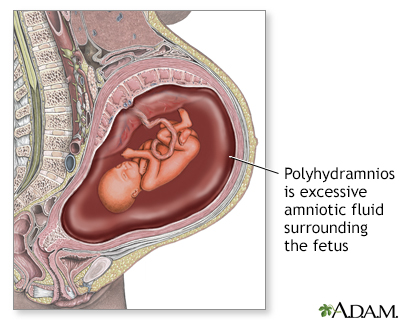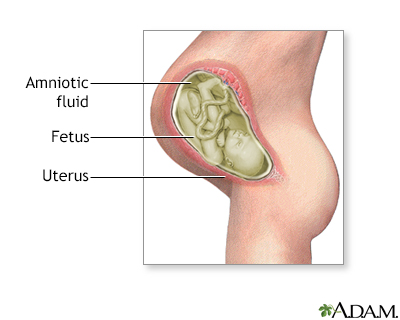Amniotic fluid
Amniotic fluid is a clear, slightly yellowish liquid that surrounds the unborn baby (fetus) during pregnancy. It is contained in the amniotic sac.
The role of amniotic fluid - Animation
Inside a pregnant woman’s uterus is an amniotic sac, which contains amniotic fluid and the growing fetus. The amniotic fluid is important for several reasons -- it helps keep the baby warm, and because his body parts are growing so fast, the fluid provides lubrication that keeps them from growing together. In some cases, fingers and toes can become webbed as a result of not enough amniotic fluid circulating in the uterus. The amniotic fluid also lets the baby move easily so he can exercise his muscles and strengthen his bones before he’s born. In addition, it acts like a liquid shock absorber for the baby by distributing any force that may push on the mother’s uterus. Even sex won’t hurt the baby. Amniotic fluid is 98% water and 2% salts and cells from the baby. Until the fetal kidneys started working during month four, amniotic fluid is made by the mother’s body. But after month four, the little guy started to make his contribution to the amniotic fluid by urinating in it. You heard right. It may not sound appealing to us, but the urine in the amniotic sac is completely harmless to the baby. The baby swallows amniotic fluid, which then passes through his digestive system, into his kidneys, and back out again to the amniotic sac as urine. In this way, he can practice using his digestive and urinary systems before he’s even born. In fact, doctors can tell by the amount of amniotic fluid whether the baby has difficulty with his swallowing reflex. By the time he’s born, he will consume up to 13 ounces of amniotic fluid a day.
Information
While in the womb, the baby floats in the amniotic fluid. The amount of amniotic fluid is greatest at about 34 weeks into the pregnancy (34 weeks gestation), when it averages 800 milliliters (mL). About 600 mL of amniotic fluid surrounds the baby at full term (40 weeks gestation).
Gestation
Gestation is the period of time between conception and birth. During this time, the baby grows and develops inside the mother's womb. Gestational ag...
Read Article Now Book Mark ArticleThe amniotic fluid constantly moves (circulates) as the baby swallows and "inhales" the fluid, and then releases it.
The amniotic fluid helps:
- The developing baby to move in the womb, which allows for proper bone growth
- The lungs to develop properly
- Prevent pressure on the umbilical cord
- Keep a constant temperature around the baby, protecting from heat loss
- Protect the baby from outside injury by cushioning sudden blows or movements
Too much amniotic fluid is called polyhydramnios. This condition can occur with multiple pregnancies (twins or triplets), congenital anomalies (problems that exist when the baby is born), or gestational diabetes.
Polyhydramnios
Polyhydramnios occurs when too much amniotic fluid builds up during pregnancy. It is also called amniotic fluid disorder, or hydramnios.

Gestational diabetes
Gestational diabetes is high blood sugar (glucose) that starts or is first diagnosed during pregnancy.

Too little amniotic fluid is known as oligohydramnios. This condition may occur with late pregnancies, ruptured membranes, placental dysfunction, or fetal abnormalities.
Placental dysfunction
The placenta is the link between you and your baby. When the placenta does not work as well as it should, your baby can get less oxygen and nutrient...

Abnormal amounts of amniotic fluid may cause the health care provider to watch the pregnancy more carefully. Removing a sample of the fluid through amniocentesis can provide information about the sex, health, and development of the fetus.
Amniocentesis
Amniocentesis is a test that can be done during pregnancy to look for certain problems in the developing baby. These problems include:Birth defectsG...

Reviewed By
John D. Jacobson, MD, Professor Emeritus, Department of Obstetrics and Gynecology, Loma Linda University School of Medicine, Loma Linda, CA. Also reviewed by David C. Dugdale, MD, Medical Director, Brenda Conaway, Editorial Director, and the A.D.A.M. Editorial team.
Burton GJ, Sibley CP, Jauniaux ERM. Placental anatomy and physiology. In: Landon MB, Galan HL, Jauniaux ERM, et al, eds. Gabbe's Obstetrics: Normal and Problem Pregnancies. 8th ed. Philadelphia, PA: Elsevier; 2021:chap 1.
Gilbert WM. Amniotic fluid disorders. In: Landon MB, Galan HL, Jauniaux ERM, et al, eds. Gabbe's Obstetrics: Normal and Problem Pregnancies. 8th ed. Philadelphia, PA: Elsevier; 2021:chap 28.
Ross MG, Beall MH. Amniotic fluid dynamics. In: Lockwood CJ, Copel JA, Dugoff L, et al, eds. Creasy and Resnik's Maternal-Fetal Medicine: Principles and Practice. 9th ed. Philadelphia, PA: Elsevier; 2023:chap 4.





 All rights reserved.
All rights reserved.